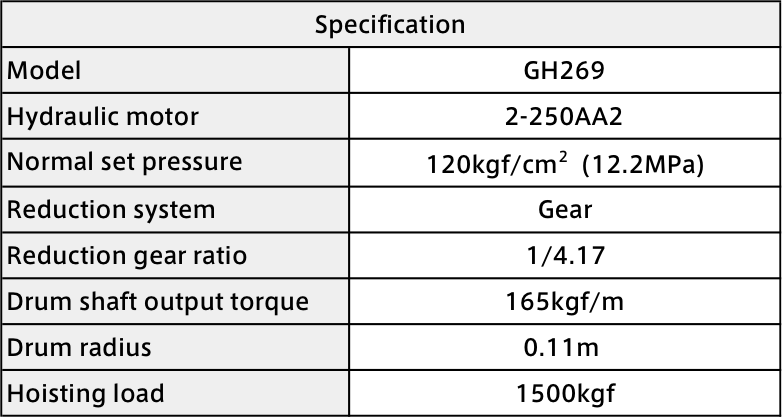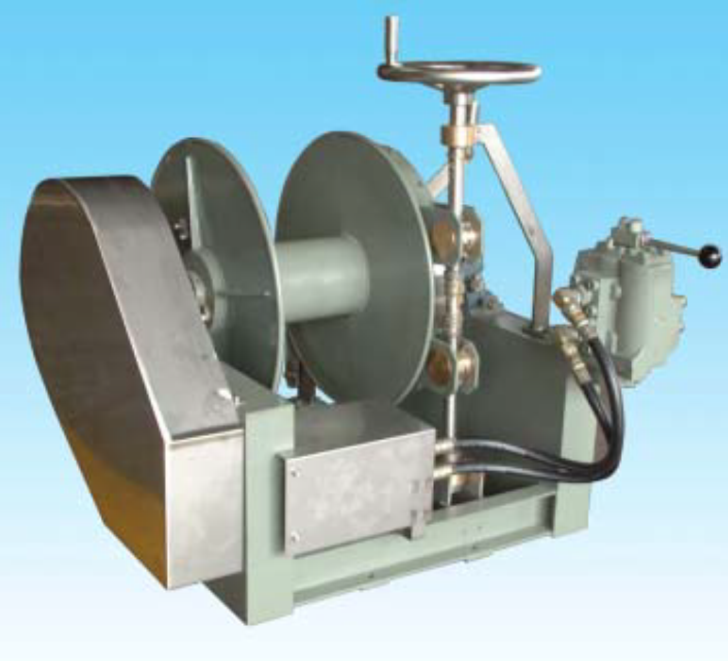Winch for Dredge Net
Winch for Dredge Net
This model is mainly used to dredge scallops and sea cucumbers from the bottom of the sea.
This model also contributes to the efficiency, the labor saving and
the volume of landings.
SUS304 is used for main parts and it is superior to corrosion-resistance due to the zinc plating.
Outer dimension

Specification
Ex) Model : GH269

I Main calculation formula of hydraulic pressure device
-
Hydraulic pump
- 1) axis input of a pump
Ls=(P・Q/60η)・102 - 2) Oil power of the pump
Lp= P・Q/60=η・Ls・10-2 - 3) Total efficiency of the pump
η=ηv・ηt・10-2 - 4) Capacity efficiency of the pump
ηv=(Q/Qth)・100≒(Q/Q0)・100 - 5) Efficiency of the motor
ηe= Ls/ Le
- 1) axis input of a pump
-
Hydraulic motor
- 1) Theoretical Displacement volume of Hydraulic motor
Dth=(2π・T)/(P・ηt)・102 - 2) Output power of Hydraulic motor
Ls=2π・T・N/60000=η・(P・Q/60)・102 - 3) Input power of Hydraulic motor
Lm=P・Q/60 - 4) Capacity efficiency of Hydraulic motor
ηv= (Dth・N/Q)・10-1 - 5) Torque efficiency of Hydraulic motor
ηt= (2π・T/P・Dth )・102 - 6) Total efficiency of Hydraulic motor
η=ηv・ηt・102= (Ls/ Lm)・102=(2π・T・N/P・Q)・10-1
- 1) Theoretical Displacement volume of Hydraulic motor
-
Cylinder
- 1) Necessary pressure to a cylinder
P1=(1/ A1)・(F/ηc+P2・A2・102) ・10-2 - 2) Necessary flow rate for a cylinder
Q= A1・v・10-1+QL - 3) Driving force of a cylinder
Acceleration ability
F1=m・α=m・v1/t
Static wear resistance
F2= μs・m・g
Dynamic wear resistance
F3= μd・m・g
- 1) Necessary pressure to a cylinder
The explanations of symbols
Ls: input of pump shaft, output power of the motor, the output power of the motor (kW)
Lp: oil power of the pump (kW)
Le: input power of the motor (kW)
Lm: input power of the motor (kW)
P: Discharge pressure of pump, differential-pressure of the input/output port of a motor (MPa)
P1: necessary pressure to cylinder (MPa)
P2: pressure of the cylinder inflow (MPa)
Q: discharge amount at the time of discharge pressure P,
inflow oil amount to the motor, necessary flow rate of the cylinder (large/min)
Qth: theoretical discharge amount (l/min)
Qo: discharge amount at the time of discharge pressure P≒0, (l/min)
QL: Leak inside the cylinder (l/min)
T: shaft torque (N・m)
N: number of rotations (min-1)
η: Total efficiency of the pump, total efficiency of the motor (the %)
η v: capacity efficiency of pump, capacity efficiency of the motor (the %)
η t: torque efficiency of pump, torque efficiency of the motor (the %)
η e: efficiency of motor (the %)
η c: driving force efficiency of cylinder (0.9-0.95)
Dth: theoretical displacement volume of the motor (cm3/rev)
A1: inlet side pressure receiving area of cylinder (cm2)
A2: outlet side pressure receiving area of cylinder(cm2)
F: cylinder driving force (N)
F1: cylinder acceleration force (N)
F2: static wear resistance (N)
F3: dynamic wear resistance (N)
v: The speed of the cylinder (m/min)
v1: The speed after acceleration (m/s)
m: The mass of the load (KG)
α: acceleration (m/s2)
t: acceleration time (s)
μ s: static friction coefficient
μ d: dynamic friction coefficient
g: acceleration of the gravity (m/s2)

